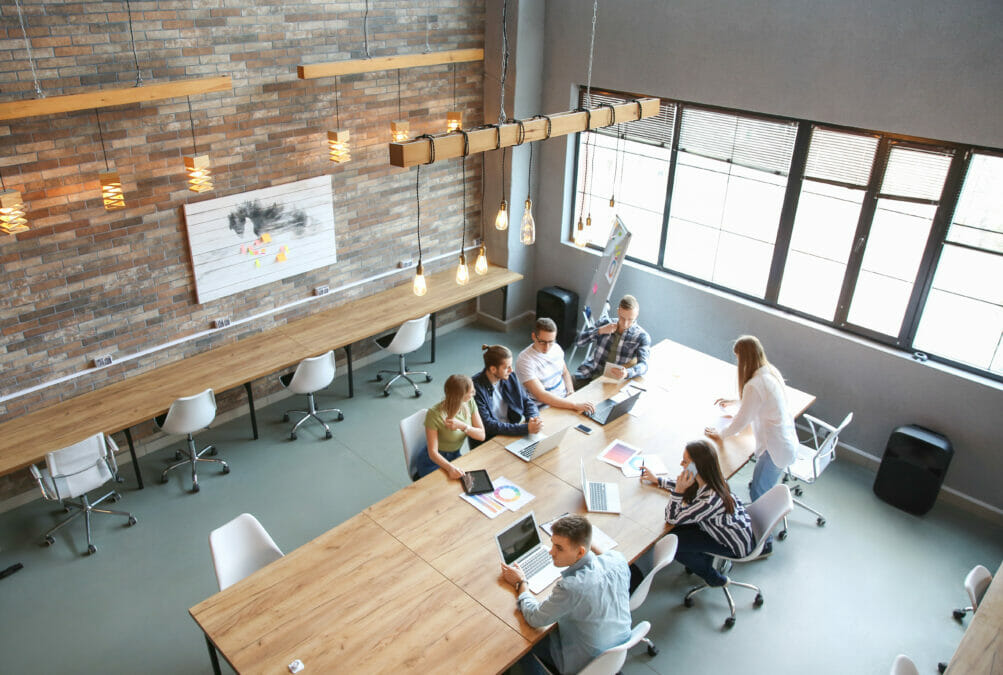“The Deal” was a flexible work commitment for employees announced in March by one of the UK’s biggest employers, PwC, in response to changing working patterns. It outlined, amongst other initiatives, an ‘empowered day’ in which workers could decide the most effective working pattern for them, on any given day.
A blended office model is a flexible approach, mixing both in-office and remote work. Creating successful blended working environments in a people-centric workplace is important to both PwC and Logitech. We share our experiences of remote working, and discuss how relationship-driven organisations, such as sales and consultancies, will operate a blended office model.
The manager’s role
Dara: Simon and I both have team and line management duties, with responsibilities to ensure employees have a rewarding career, and they have clear role progression. To do this properly our remits have expanded so they are much more about employee wellbeing, as well as performance. For me it’s always been critical to ensure productivity and happiness because I see the value in team management and it’s one aspect of my role that I most enjoy, but it’s become ever more important as we adapt to blended office life.
Being able to understand mood and sentiment is hard if everyone is working in different locations, so video is a key tool in helping us to read one another’s body language. We also have to be much more purposeful on a day-to-day basis with the planning of when to check in on reports and teams and maintain communication across those who are in the office and remote.
Simon: I totally agree. We have to create spontaneous moments that many found were more easily facilitated with coffee catch ups in the office. Moments where no one raised an eyebrow as to whether they were a time-wasting exercise, instead thinking the 30 minutes could be spent more productively in an online meeting. It’s why, in the hybrid world, Logitech has given new employees a lot more time when onboarding, ensuring new starters are given the chance to interact with online training, engage, be human, and feel supported.
Dara’s spoken about video, and I want to emphasise technology’s role in facilitating the way we are able to forge new, rich relationships with colleagues and clients in the hybrid working world. For example, you can no longer simply equip a boardroom with one video conferencing camera at the head of a long table. It creates ‘tunnel view vision’ in which a sea of heads all lean forward to speak like dominoes. Technology has to work for everyone so that attendees, wherever they are (at the end of the boardroom socially distanced from colleagues, in-person, or on video) to participate.
Why the future of service is hybrid
Business, experience and technology
Dara: The point is we’ve been speaking about the need for investment in technologies and digital transformation for some time now. The senior leadership teams of the clients we advise have prioritised this, especially from the perspective of the future of work. So, these trends have always been in place – but the pandemic has forced businesses’ hand further.
My point of view on this comes from three lenses, shaped by my role as UK lead of BXT (Business, Experience and Technology). Organisations that are successfully transforming their operations to live and breathe this new blended universe are thinking about these three elements as interconnected. New technology must align to the business value organisations are trying to create but at the heart of all of this is the person, and the way they benefit from the technology that is put in place. This could be a set up with two screens that helps an employee to be more productive, or an easy-to-use communication platform to allow teams to stay connected from anywhere.
Simon: Now, the need for a blended sales environment has resulted in greater use of technology to drive customer engagement, retention and good client experiences. Equipping offices (home and corporate) to ensure a seamless virtual meet is just practical. Everyone, whether in physical attendance or remote, must feel involved in conversation.
Technology can equip us for this, with video conferencing cameras able to auto frame faces and align them so everyone is shown on the screen.
What does a post-pandemic future of work look like?
Simon: Reflecting on the past year, I’m unsure if we can assertively predict what the next three to five years will look like. But allow me to reflect on this. Firstly, the employee and customer experience is now central to all business matters. This means that working patterns that emerged before the pandemic but became our only known entity because of enforced, global lockdowns, are here to stay. The questions now is: how do we now bring together the best of both worlds?
Over the past year and a half, we’ve discovered new ways of working that we can’t afford to lose when the economy opens up again. Working virtually for two to three days a week, or however you choose, gives a flexibility of choice that not only enriches and improves the life of the person, but the organisation should see the return too. That, and allow me to consider society’s next big threat – the climate emergency. There’s another, truly important argument to be made on the benefits of a blended working environment, that equipping workers with the right technology effectively, means travel, even international business travel, can be reduced and carbon emissions be mitigated. Watch this space: the office dynamic is going to continue to evolve.








